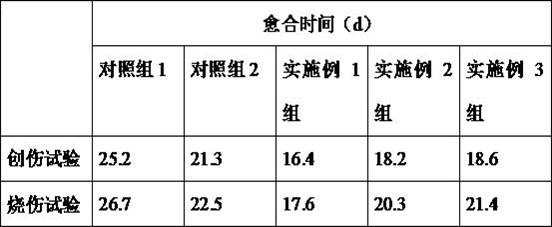A kind of biological cellulose composite gel material and its application as wound dressing
A technology of biocellulose and wound dressings, which is applied in the preparation of wound dressing products, and in the field of biocellulose composite gel new materials, which can solve problems such as limiting cell adhesion and proliferation, and application limitations of biocellulose
- Summary
- Abstract
- Description
- Claims
- Application Information
AI Technical Summary
Problems solved by technology
Method used
Image
Examples
Embodiment 1
[0024] Example 1: Preparation Example 1 of Composite Gel Material
[0025] 1) Preparation of biocellulose hydrogel film by static fermentation method: use coconut water medium, Acetobacter xylinum, ferment and culture in shallow tray at 28°C for 7 days, and collect the biocellulose hydrogel film on the liquid surface . After cleaning and purification, it can be used for later use;
[0026] 2) Dehydrate the biocellulose hydrogel membrane to a water content of 60% by mechanical pressure, then soak it in a 0.7wt% globulin solution, ultrasonically shake it for 6 hours, take it out and wash it with water;
[0027] 3) Take 0.05M sodium chloride solution, adjust the pH value to 4 with dilute hydrochloric acid, heat it to 80°C, then immerse the biocellulose hydrogel film obtained in step 2) in it, and heat and keep it for 5 hours;
[0028] 4) Take out clean water and wash.
[0029] That is, the composite gel material of the present invention is obtained.
Embodiment 2 : preparation example 2
[0031] 1) Preparation of biocellulose hydrogel membranes by static fermentation method: using artificially prepared medium, Acetobacter xylinum, fermented and cultured in shallow trays at 29 °C for 9 days, and collected the biocellulose hydrogel membranes on the liquid surface . After cleaning and purification, it can be used for later use;
[0032] 2) Dehydrate the biocellulose hydrogel membrane to a water content of 40% by mechanical pressure, then soak it in a 1wt% ovalbumin solution, ultrasonically shake it for 8 hours, take it out and wash it with water;
[0033] 3) Take 0.2M calcium chloride solution, adjust the pH value to 5 with dilute hydrochloric acid, heat to 70°C, and then immerse the biocellulose hydrogel film obtained in step 2) into it, and heat and maintain for 4 hours;
[0034] 4) Take out clean water and wash.
Embodiment 3
[0035] Example 3: Preparation Example 3 of Composite Gel Material
[0036] 1) Preparation of biocellulose hydrogels by shaker dynamic fermentation method: use artificially prepared medium, Acetobacter xylinum, and shaken dynamic fermentation culture at 27°C for 5 days, collect biocellulose hydrogels, wash and purify them for later use use;
[0037] 2) The collected biocellulose hydrogel was pressed into a film by mechanical pressure, and dehydrated to a water content of 70%, then immersed in a 3wt% soybean protein solution, ultrasonically vibrated for 16 hours, taken out, and washed with water;
[0038] 3) Take 0.1M sodium chloride solution, adjust the pH value to 3 with dilute hydrochloric acid, heat to 65°C, and then immerse the biocellulose hydrogel film obtained in step 2) into it, and heat and maintain for 6 hours;
[0039] 4) Take out clean water and wash.
PUM
 Login to View More
Login to View More Abstract
Description
Claims
Application Information
 Login to View More
Login to View More - R&D
- Intellectual Property
- Life Sciences
- Materials
- Tech Scout
- Unparalleled Data Quality
- Higher Quality Content
- 60% Fewer Hallucinations
Browse by: Latest US Patents, China's latest patents, Technical Efficacy Thesaurus, Application Domain, Technology Topic, Popular Technical Reports.
© 2025 PatSnap. All rights reserved.Legal|Privacy policy|Modern Slavery Act Transparency Statement|Sitemap|About US| Contact US: help@patsnap.com

